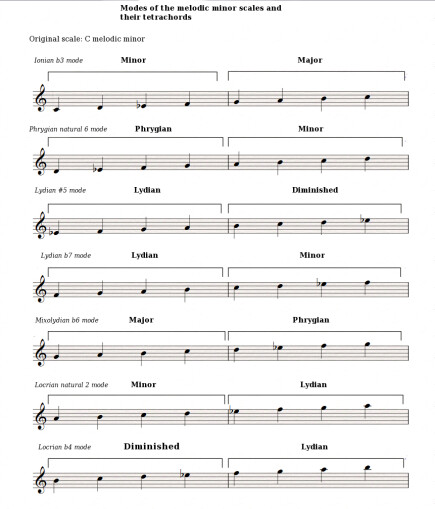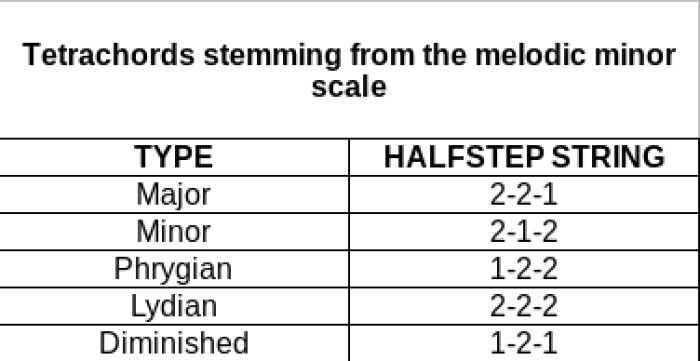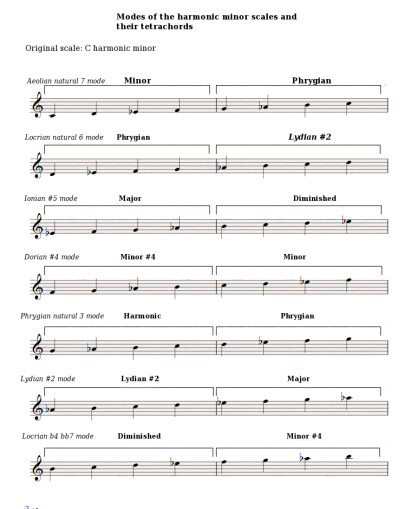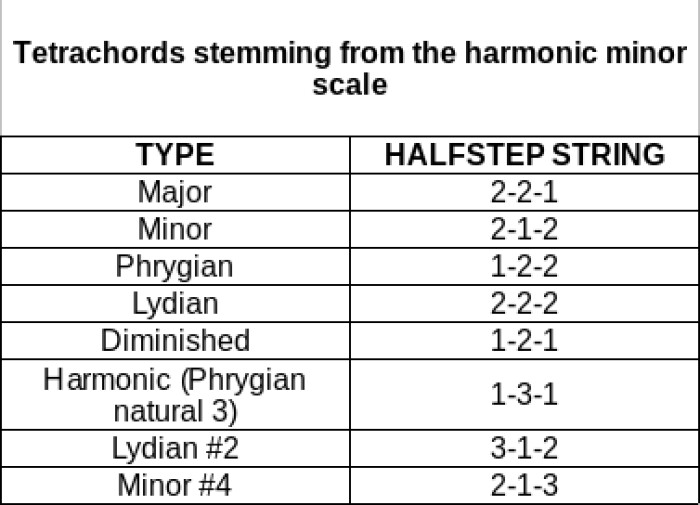After having reviewed in our last article the synthetic scales resulting from the taking apart of natural modes and the redistribution of their tetrachords, let's see what you get when you do the same with altered modes.

Let’s begin with what you can achieve with the modes of the melodic minor scale (article 56).
Tetrachords of the melodic minor scale modes
If you look at the modes of the melodic minor scale, you’ll realize that the tetrachords that make them up are the same as those of the natural modes, with the addition of a new one: the diminished tetrachord. The latter is made up of semitone, whole tone, semitone intervals, or 1–2–1 according to the code established in article 64.
This tetrachord appears in the Lydian #5 mode (3th mode) and in the Locrian b4 mode (7th mode):
Below you can find a summary of all the tetrachords found in the tetrachords of the altered modes of the melodic minor scales:
Like in the previous article, let’s see what happens when you mix all of these “bricks”!
Putting together tetrachords of the melodic minor scale
Since most of the tetrachords are identical to those of the natural modes, we will focus mainly on those which include the new element introduced, namely the diminished tetrachord.
Putting together a diminished tetrachord and a major tetrachord you get a scale stemming from the Jewish tradition, the Magan Abot scale:

Combining a diminished tetrachord and a minor tetrachord you get another scale stemming from the Jewish tradition, with a very similar name to the previous one, the Magen Abot scale:

Putting together a diminished and a Phrygian tetrachord, you get the so-called “Shostakovich” scale:

Combining a major and a diminished tetrachord, you get the following scale (whose name we don’t know; so if anyone out there does, do share it with the rest of us!):

Combining a minor and diminished tetrachord, you get the diminished scale (whole tone-semitone):

Putting together a Phrygian and a diminished tetrachord, you get the so-called “Hamel” scale:

Combining two diminished tetrachords, you get the half-diminished scale (semitone/whole tone) described in article 59:

To wrap up this article I invite you to discover the modes stemming from the harmonic minor scale!
Tetrachords of the harmonic minor scale modes
In this case, you’ll find once again the omnipresent major, minor and Phrygian tetrachords, as well as the diminished mode mentioned above.
But there are three new tetrachords: the harmonic tetrachord also called Phrygian natural 3 (1–3–1), the Lydian #2 tetrachord (3–1–2) and the minor #4 tetrachord (2–1–3). They all feature an interval of three semitones, which is characteristic of the modes of the harmonic minor scale.
Below is a table of the tetrachords of the harmonic minor scale:
Next time you’ll learn how to combine them!











